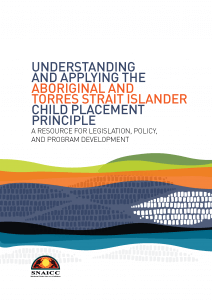
Understanding and Applying the Aboriginal and Torres Strait Islander Child Placement Principle
This blog entry was authored by SNAICC Secretariat of
National Aboriginal & Islander Child Care.
The Aboriginal and Torres Strait Islander Child Placement Principle (ATSICPP) exists as a key measure to ensure connections with family, community, culture, and country are prioritised in legislation, policy and practice.
It was founded on an intent of systemic change to counter embedded racism that caused the Stolen Generations by explicitly recognising the value of culture and the vital role of Aboriginal and Torres Strait Islander children, families and communities to participate in decisions about the safety and well-being of children.

The ATSICPP aims to:
- ensure an understanding that culture underpins and is integral to safety and wellbeing for Aboriginal and Torres Strait Islander children is embedded in policy and practice;
- recognise and protect the rights of Aboriginal and Torres Strait Islander children, family members and communities in child welfare matters;
- increase the level of self-determination of Aboriginal and Torres Strait Islander people in child welfare matters; and
- reduce the over-representation of Aboriginal and Torres Strait Islander children in child protection and out-of-home care systems.
- SNAICC – National Voice for our Children has been working to analyse each state and territory’s current compliance with the ATSICPP as measured against the best-practice framework. This work has involved extensive consultation with our members and state peak bodies in order to reflect Aboriginal and Torres Strait Islander community practice experience, and demands for better compliance with the ATSICPP.
This work also provides an opportunity to engage with each state and territory’s child protection department in a way that instils a better understanding of the ATSICPP and affects change.As part of SNAICC’s role in supporting the Aboriginal and Torres Strait Islander Working Group formed under the Third Three-Year Action Plan 2015-2018 of the National Framework for Protecting Australia’s Children 2009-2020, SNAICC has worked in partnership with the Working Group and other Aboriginal and Torres Strait Islander leadership to develop a resource to guide the implementation of the ATSICPP.
The National Framework is a long-term collaboration between Commonwealth, State and Territory Governments – endorsed by the Council of Australian Governments (COAG) in 2009 – and non-government organisations to promote and enhance the safety and wellbeing of Australia’s children. It is premised on a goal to introduce a public health model to keep children safe and well, focusing on providing the universal and targeted supports that will prevent children entering out-of-home care.
Understanding and Applying the Aboriginal and Torres Strait Islander Child Placement Principle: A resource for legislation, policy, and program development provides a description of the Aboriginal and Torres Strait Islander Child Placement Principle and definition of its five core and interconnected elements: prevention, partnership, placement, participation, and connection. To access the principle click here.
 Presented in a format that is easy to follow and absorb, the resource provides a detailed description of each of the five core elements of the Aboriginal and Torres Strait Islander Child Placement Principle.
Presented in a format that is easy to follow and absorb, the resource provides a detailed description of each of the five core elements of the Aboriginal and Torres Strait Islander Child Placement Principle.
The resource also details a best-practice approach to implementing the ATSICPP against the system elements of legislation, policy, programs, processes, and practice.
In reviewing best practice to implementing the ATSICPP, the resource examines the intersectionality of the elements, outlining the critical requirement for holistic processes of reform to ensure each considered system (legislation, policy, programs, process and practice) aligns with the ATSICPP.
Understanding and Applying the Aboriginal and Torres Strait Islander Child Placement Principle was launched in June 2017, being widely distributed and promoted, and has been well received by both policy makers and practitioners.
SNAICC plans to develop future resources in this series, including:
- Baseline analysis of the progress of States and Territories to implement the Aboriginal and Torres Strait Islander Child Placement Principle; and
- a resource for child and family services practitioners on applying the five elements of the ATSICPP.
SNAICC – National Voice for our Children is the national non-government peak body for Aboriginal and Torres Strait Islander children. We work for the fulfilment of the rights of our children, in particular to ensure their safety, development and wellbeing.
